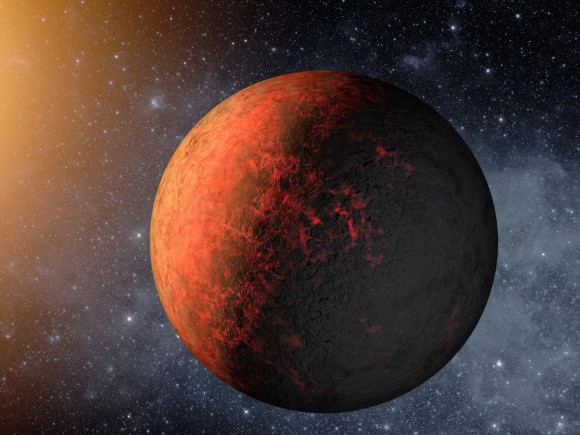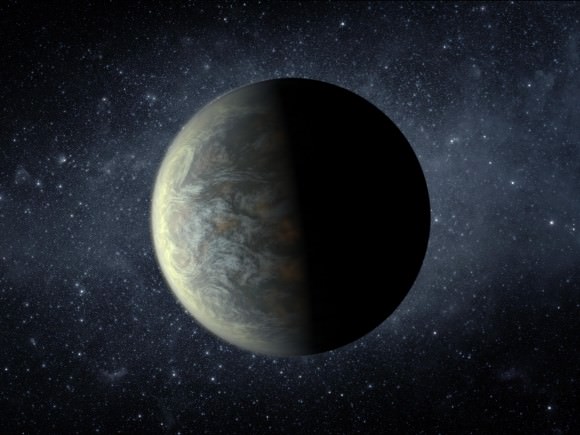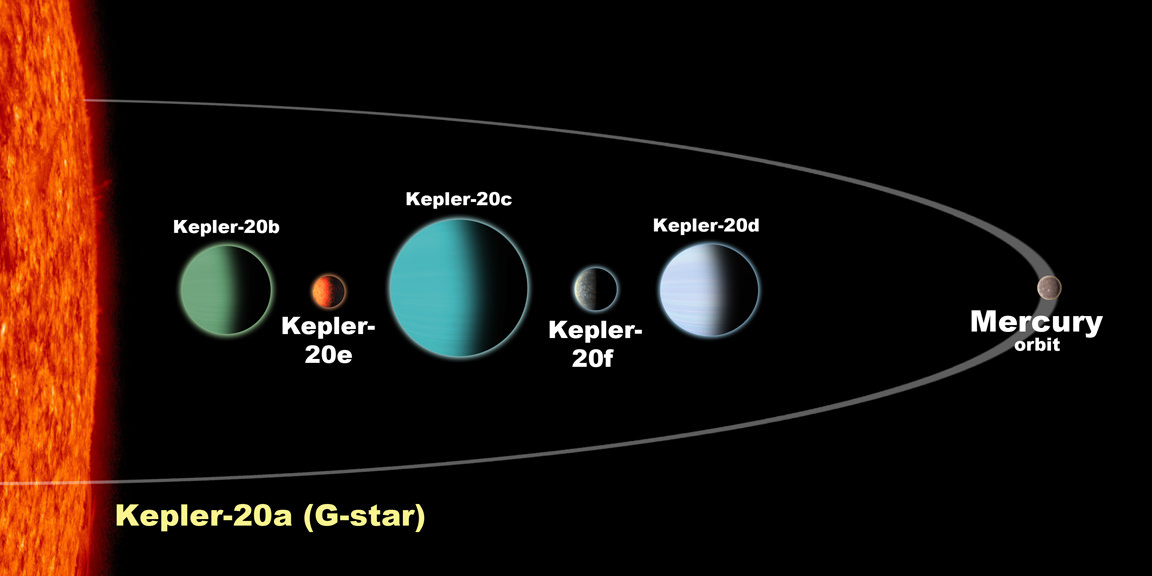[/caption]
December 2011 will go down in history as the first time humanity was able to detect an Earth-sized planet around another Sun-like star, said Francois Fressin, an astronomer from Harvard-Smithsonian Center for Astrophysics. Fressin and his team used the Kepler planet-hunting spacecraft to find two rocky worlds – one just a bit bigger than Earth and the other slightly smaller than Venus.
The two planets, named Kepler-20e and 20f, are the smallest planets found to date. They have diameters of 11,000 km (6,900 miles) and 13,190 km (8,200 miles) – equivalent to 0.87 and 1.03 times Earth. Astronomers expect these worlds to have rocky compositions, so their masses should be less than 1.7 and 3 times Earth’s.
The two worlds are part of a multiple-planet system with five planets around the same star, and is located about 1,000 light years away in the constellation of Lyra. “People can point to that area in the sky and say this is where the era of exo-Earth’s began,” said Fressin, adding that the two rocky worlds are too close to their star — and thus too hot — to be habitable.

Kepler-20e orbits every 6.1 days at a distance of 4.7 million miles. Kepler-20f orbits every 19.6 days at a distance of 10.3 million miles. Due to their tight orbits, they are heated to temperatures of 760 Celcius (1,400 degrees Fahrenheit) and 426 C (800 degrees F.)
The solar system where these planets exists is quite unusual, where rocky and gas planets alternate in their positions instead of being separated into groups like in our own solar system.
The first planet is a Neptune-like world; then the first rocky planet, Kepler 20e; next is another Neptune world; following is the next rocky world 20f, and then another Neptune-like gas planet.
“So, big, little, big, little, big — which is unlike any other system so far,” said David Charbonneau, from Harvard University. “We were surprised to find this system of flip-flopping planets. It’s very different than our solar system.”
Additionally, all the planets are very closely compact, lying within the orbit of Mercury around our Sun.
This unusual system of alternating planets may not be unusual at all, as our sample of solar systems is still relatively small.
“This really is a problem for our community to explain,” said Linda Elkins-Tanton, director of the Carnegie Institution for Science’s Department of Terrestrial Magnetism in Washington, in response to a question posed by Universe Today about the dynamics of such a system. “We are really challenging the community for the reason why this happened, and it may well be that our solar system may be in the minority.”

The astronomers don’t think the planets of Kepler-20 formed in their current locations. Instead, they must have formed farther from their star and then migrated inward, probably through interactions with the disk of material from which they all formed. This allowed the worlds to maintain their regular spacing despite alternating sizes.
“We think they migrated because we can’t imagine all this stuff so close to the star, where it is warm and only portions of the material is in solid form,” Charbonneau told Universe Today. “We think the birth place of a Neptune-like world is farther from the star and then over time the planets migrate in. Wouldn’t be surprised if we see more systems like this as we keep exploring.”
Asked when the Kepler team might find a “best of both worlds” planet — one that is the right size and in the right place to be habitable, Nick Gautier, Kepler project scientist said they may find one in the next year or two, but the Kepler mission may need an extension to ensure finding the Holy Grail of exoplanets — one that is just like Earth.
Kepler identifies “objects of interest” by looking for stars that dim slightly, which can occur when a planet crosses the star’s face. To confirm a transiting planet, astronomers look for the star to wobble as it is gravitationally tugged by its orbiting companion (a method known as radial velocity).
The radial velocity signal for planets weighing one to a few Earth masses is too small to detect with current technology. Therefore, other techniques must be used to validate that an object of interest is truly a planet.
A variety of situations could mimic the dimming from a transiting planet. For example, an eclipsing binary-star system whose light blends with the star Kepler-20 would create a similar signal. To rule out such imposters, the team simulated millions of possible scenarios with Blender – custom software developed by Fressin and Willie Torres of CfA. They concluded that the odds are strongly in favor of Kepler-20e and 20f being planets.
Fressin and Torres also used Blender to confirm the existence of Kepler-22b, a planet in the habitable zone of its star that was announced by NASA earlier this month. However, that world was much larger than Earth.
“These new planets are significantly smaller than any planet found up till now orbiting a Sun-like star,” added Fressin.
For further reading:


I’m hoping some of these new planet discoveries harbor life (which I’m sure is on everyone’s mind), but am also increasingly thinking we may be alone. What we do know, is that some sort of star trek-like scenario, with solar systems teeming with life that can travel great distances freely with some exotic propulsion systems, isn’t the case. Otherwise presumably we’d have seen something by now: some evidence of visitors, on the moon, mars, alien probes, Seti, even credible UFO video/images…*something*. But instead, absolutely *nothing* so far.
I also think it’s too much extrapolation to say the oft-repeated “we can’t be alone; there are just too many stars/galaxies in the universe”. Because it’s simply a matter of numbers, and IMO, we simply don’t know enough at all about the probabilities or processes involved in the generation of “first life” on a planet. The Drake equation is useless because, aside from being self-apparent and unnecessary, you need to know the answer before you can use it.
Has it been demonstrated what conditions can lead to life emerging? It comes down to that; and about that, we’re pretty much guessing…
“Space,” it says, “is big. Really big. You just won’t believe how vastly, hugely, mindbogglingly big it is. I mean, you may think it’s a long way down the road to the chemist’s, but that’s just peanuts to space, listen…”
Here is a question for everyone: Though obviously it’s absence would not be, but would discovery of life on other bodies in our own solar system be viewed as a satisfying answer to this question?
Regarding exo-conditions, by default we have one absolutely fantastic example set to be on the lookout for, though in my opinion attributing those conditions to the actual cause of emergence of life may be a long bow to draw until we have sight of it’s origin, or cause as it were. I said the above because I’m uncomfortable with the idea that with favourable conditions and “time”, life will “emerge”. It sounds merely like a modern version of spontaneous generation.Until then I view our solar system’s conditions as the logical top of the search list, for existing life.
To base research into abiogenesis in the Fermi question is IMO misguided. That question is too little constrained to be of real value.
For example, I maintain that a natural pathway for colonization would be into the volatile and habitat rich Oort clouds between stars. At which time the migration wave would turn silent, because they would never be interested in costly communication nor costly planetary
colonization.
As for abiogenesis, if we look at the type case we know, the speed with which life was established on Earth shows that it is an easy process.
Yes, it has been predicted, and as it turned out a few years back testably so.
– The first case I know of is Wäschterhäuser’s surface metabolic theory of 1988, which was constructed as a complete and testable theory. 2008 were was a paper that IMHO rejected it by showing how its catalysts would need to be at least as proficient as modern enzymes, an unlikely occurrence.
This theory predicted very specific environmental conditions.
– The second case should pass test and is the one I have presented here before.
To reiterate, bottom up chemical network enzymes are a natural outcome. High-temperature reactions seems to be much faster than orthodox theory predicted from scant data. This temperature dependence gives a self-selection for enthalpic pre-proteinous enzymes. [“Impact of temperature on the time required for the establishment of primordial biochemistry, and for the evolution of enzymes”, Stockbridge et al, PNAS, 2010.]
Top down, we see that pathways meet. The first modern metabolic networks originated with purine metabolism, and specifically with the gene family of the P-loop-containing ATP hydrolase fold. [“The origin of modern metabolic networks inferred from phylogenomic analysis of protein architecture”, Caetano-Anollés et al. PNAS, 2007; “Rapid evolutionary innovation during an Archaean genetic expansion”, David et al, Nature, 2010.]
That is, the coenzyme ATP sits at the intersection between a cooling planet pre-metabolism and nucleotide proto-metabolism. Minimum change of traits picks ATP use before RNA evolution. And such a character phylogeny is a standard test for evolution.
This scenario predicts loose conditions of a terrestrial planet forming which ends up having liquid water present. Going back to that it is a rather easy process.
Either way, astrobiology seems to have left simply putting up hypotheses and entered mainstream science with ability to pare them down with tests.
If this literature is as you state, then these are good steps forward. I guess I’m just saying there’s a lack of data related to generating life. An analogy would be having a full periodic table in front of you but having no physical matter to actually study. We would never predict all the variety of compounds and behaviors of matter. We’re not too smart when it comes to things like that. 😀
I would say the turning point, the “matter to actually study” in my analogy, is when we can create life in the laboratory that looks like our single-celled life on earth. Then it will be a very simple matter to determine the correct conditions. The elements are few and I agree they should be easy to combine. Hopefully that will happen soon. Maybe that it seems so simple yet hasn’t been done, shows that something else strange is happening. (I’m not suggesting anything in particular).
Abiogenesis of life must occur somewhere. The universe has only existed 13.7 billion years, and so it had to start somewhere. It is also like that the universe on a generic level and large scale is similar everywhere, and so abiogenesis has repeated on many planets.
I am not sure what you mean by colonization here. It is not clear to me how life could end up in the Oort cloud region, unless you mean intelligent life. Of course the problem is that it is damned cold out there.
This observation confirms what we suspected all along, which is that Earth-Venus sized planets are fairly common in the universe. So undoubtedly there are billions of them in our galaxy, with some percentage in the habitable zone.
LC
The reason the 3d Kepler release added some ~ 1000 exoplanet candidates more to get to an astounding 2326 candidates [Wikipedia] is partly the reason why the mission is asking for an extension, the presence of noise. It turns out that our Sun, while not being atypical, is just shy of the average irradiation noise of a star. (Mostly astroseismological noise.)
Unfortunately that extension is a doubling of the original mission, ~ 7 years instead of ~ 3.5 years. (Despite the average noise isn’t that severe.)
Let us hope they can get yearly extensions that long despite NASA’s budget problems!
If I understand the first Kepler conference seminars, this ties in to the unexpected blending of sizes between terrestrials and neptunians.
Earlier migration models kept them separate by allowing neptunians long enough time to grow massive before migrating in. Then you get a mass gap that is not seen in the Kepler data, but rather that gap is the most populated.
One way out is to have larger interaction (frictional breaking) between planets and the planetary disk during formation and migration. Then the neptunians would mix in size but also orbits, which is seen here.
A migration model such as the Nice model and its followers predicts many features of our own system. As long as all systems are more or less migratory, it is better to say that they are widely diverse.
The interesting measure is how many habitable terrestrials we will find in the habitable zone.
Although overcoming the technical hurdles necessary to find planets so small is impressive, this announcement is still a bit of a letdown. I think expectations are reasonable now for habitable planets, not Earth-sized Vulcans.
I don’t see how it can possibly be a let down… it points towards what we hope to be true.
I think the only let-down announcement would be something along the lines of “welp, we checked everywhere, no exoplanets”
IIf I recall, with few exceptions, Star-Worlds are repeatedly being discovered in apparent stages of advanced disorder (a sign of age in my mind). Where once they were spaciously arrayed outwards in orderly fashion, at dawns of their first light – with one or more of their orbiting members revolving within life-zones of each system (I have no doubt).
But, now, with passage of time’s neglect, they have migrated inwards (this is taking on a universal characteristic!), huddling together into turbulent tidal interactions(?), as they enter the blazing embraces of their home-stars, from slow death spirals of planet systems left in long-shadowed decay.
“The solar system where these planets exists is quite unusual, where rocky and gas planets alternate in their positions instead of being separated into groups like in our own solar system.”
One exceptionally disordered system (if inward migration did not produce transformations, or jostling billiard-ball effects) – assuming our System holds the battered, time-worn template of an ordered Planetary arrangement (and I believe it does).
I agree with another here, what is being unveiled, system by system and world by world (though of tenuous detections) – is barren waste, and definite disorder – no evidence of life: and you need an ordered – stable – system to anchor an Earth-world in the life-band of hope (if I understand). But there only seems to be the silence of lifeless desolation.
_______________
As ever, I love the alien-world portraits! Quite a collection being created, from all these worlds in space, however close the artists’ hands may come to capturing their true face.
Nicely written piece.